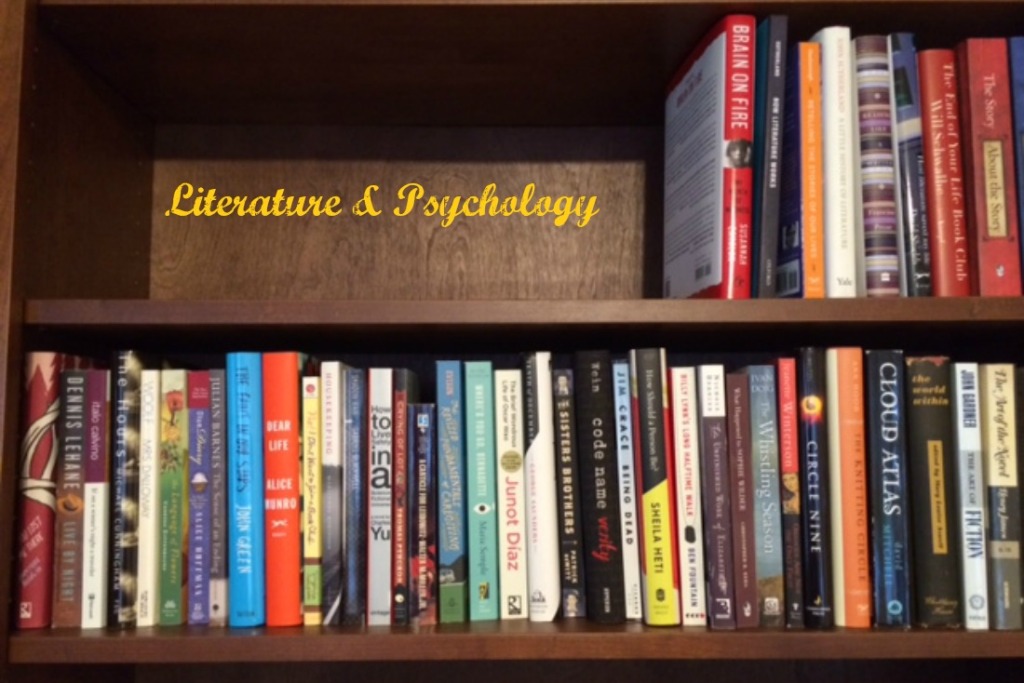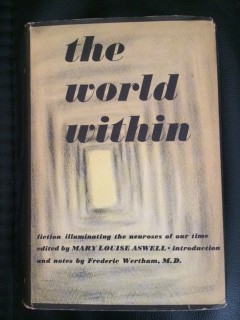The World Within: Fiction Illuminating Neuroses of Our Time
Edited by Mary Louise Aswell
Notes and Introduction by Frederic Wertham, M.D.
New York: Whittlesey House, 1947
The World Within was one of the first literary collections assembled to spotlight a psychological approach to literature. It couples a literary editor’s introductory remarks with analysis by a psychiatrist.
The literary editor was Mary Louise Aswell (1902-1984), a novelist and editor for Atlantic Monthly, Reader’s Digest, and Harper’s Bazaar. In her foreword to The World Within, which she titled “The Wing of Madness,” Aswell wrote that writer Sherwood Anderson had written in his notebook, ”When I had been working well, there was a kind of insanity of consciousness.” Aswell continued, “Anderson was one of the first generation of writers to be profoundly influenced by the great explorer of man’s consciousness, Sigmund Freud. But the source of his genius, like that of the far greater writers who precede and follow him, was his intuitive insight, as Freud would have been the first to acknowledge” (p. viii). About a writer working at the time when The World Within was published, she said, “As part of his cultural heritage he has the work of Kafka, Joyce, Proust; of D.H. Lawrence, Virginia Woolf, Thomas Mann and the writers of their generation who first interpreted Freud’s revolutionary concepts in the universal, human terms of art” (p.viii).
Frederic Wertham, M.D., (1895-1981) provided the psychiatric analysis for The World Within. He was born in Nuremberg, Germany, then studied medicine and literature at King’s College, London University, before and during the first world war. In England he became interested in Charles Dickens’s writings on social reform. After the war he received his medical degree from the University of Wurzburg in 1921 and conducted postgraduate study in Paris, Vienna, and Munich. In 1922 Wertham left Germany to work with Alfred Meyer at the Phipps Psychiatric Clinic at Johns Hopkins University in Baltimore, Maryland. He became an expert in forensic psychiatry and believed that the environment shapes individual human responses. In 1932 he moved to New York City, where he studied the effects of segregation on the lives of African American children.
Wertham studied psychiatry during the period when Sigmund Freud (1856-1939), a medical doctor, was developing the theories and method of psychoanalysis for the treatment of psychopathology. This same time period saw the beginning of the development of psychiatry as a scientific medical discipline. Freud’s theories came to dominate the field, and for Wertham psychoanalysis was synonymous with psychiatry. In his introduction to The World Within Werthem wrote that after World War I “Freud’s psychoanalysis gained a foothold with a wider audience both inside and outside the psychiatric profession. Freud’s knowledge of literature was prodigious. He explored not only the meanings hidden in the acts of persons but also those in the printed pages of books from the Greek classics to Dostoevsky. He was like an archaeologist who discovers the intact relics of an old bridge, a bridge built of myths and dreams. For the content of every neurosis is an individual myth. No wonder that this kind of psychiatry had in turn the greatest influence on literature” (p. xv). For this reason Wertham’s terminology seems strange to readers of today, for whom psychiatry usually means the use of drugs to treat mental illness.
Wertham also wrote in his introduction “Since ancient times the relationships between psychiatry and literature have been intimate and manifold, although up to the present they have remained largely unformulated” (p. xii). For him, historical myths and legends, such as ancient Greek mythology, represented timeless psychological truths that contemporary psychiatry was particularly suited to formulate: “What brings the science of psychiatry in the psychoanalytic era into such close and fruitful relationship with the art of literature is that psychoanalysis is analysis of a special kind. It does not delve into the mind to isolate disparate elements. Psychoanalysis always aims to relate the detail, the symbol, to the living organism as a whole. It is here that the research of the scientist and the search of the artist find a common ground. Great writers know how to give a unified picture of a whole personality through minute observation of a meaningful expression, a characteristic mannerism, or an unconscious habit” (p. xvi).
The World Within reflects the cultural world view of the time when it was published, a philosophical belief in the absurdity and meaninglessness of the world that had been nurtured by two world wars. Aswell called the time “this age of freedom from certainty” (p. vii). Americans know this attitude best from Holden Caulfield, the protagonist of J.D. Salinger’s 1951 novel The Catcher in the Rye. The literary works of Søren Kierkegaard, Samuel Beckett, Franz Kafka, Fyodor Dostoyevsky, Eugène Ionesco, Jean-Paul Sartre, and Albert Camus reflect a similar philosophy. Wertham referred to this time period in psychoanalytic terms: “The social crisis of our time has a close similarity to the emotional state in a neurosis: it is a want in the face of plenty. False ideals are instilled in people: for men, to produce and sell; for women, to reproduce and buy. Against this propaganda promoted by all the mass methods of modern communication, psychiatry and literature uphold the dignity of the individual in a changing world” (p. xxiv). His reference to changing gender roles as “false ideals” foreshadows The Second Sex (published in French in 1949 and in English translation in 1953) by French woman Simone de Beauvoir.
Wertham looked to literature for expressions of societal ills that needed treatment: “Literature is always—directly or indirectly, positively or negatively—a reflection of the deepest conflicts in the real life of the period” (p. xx). But he also looked to literature as a means of treating those ills, since it is in “the struggle on the frontiers of imagination where the progress of society takes place” (p. xxiv).
The World Within includes the following works:
- “The Story of Serapion,” E.T.A. Hoffman
- Notes from Underground (excerpt), Feodor Dostoevsky
- “The Beast in the Jungle,” Henry James
- “The Orchid and the Bee” (from Cities of the Plain), Marcel Proust
- “Metamorphosis,” Franz Kafka
- “Silent Snow, Secret Snow,” Conrad Aiken
- “The Door,” E.B. White
- “I Am Lazarus,” Anna Kavan
- “The Headless Hawk,” Truman Capote
- “Caput Mortuum,” Edita Morris
- “The Fury,” Robert M. Coates
- “Mrs. Razor,” James Still
- “Why I Live at the P.O.,” Eudora Welty
- “Percy Grimm” (from Light in August), William Faulkner
From time to time I will report here on one of these works.


